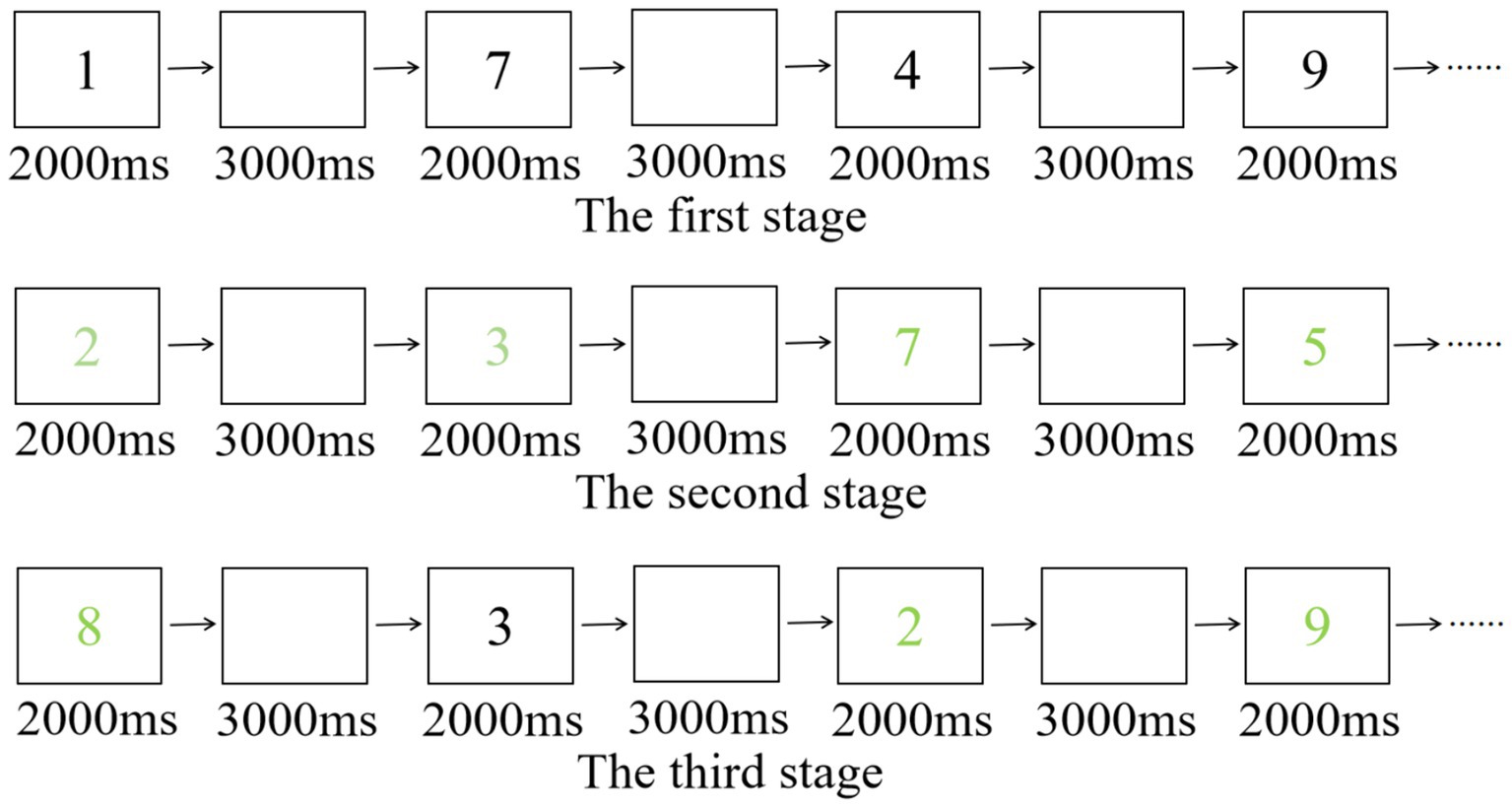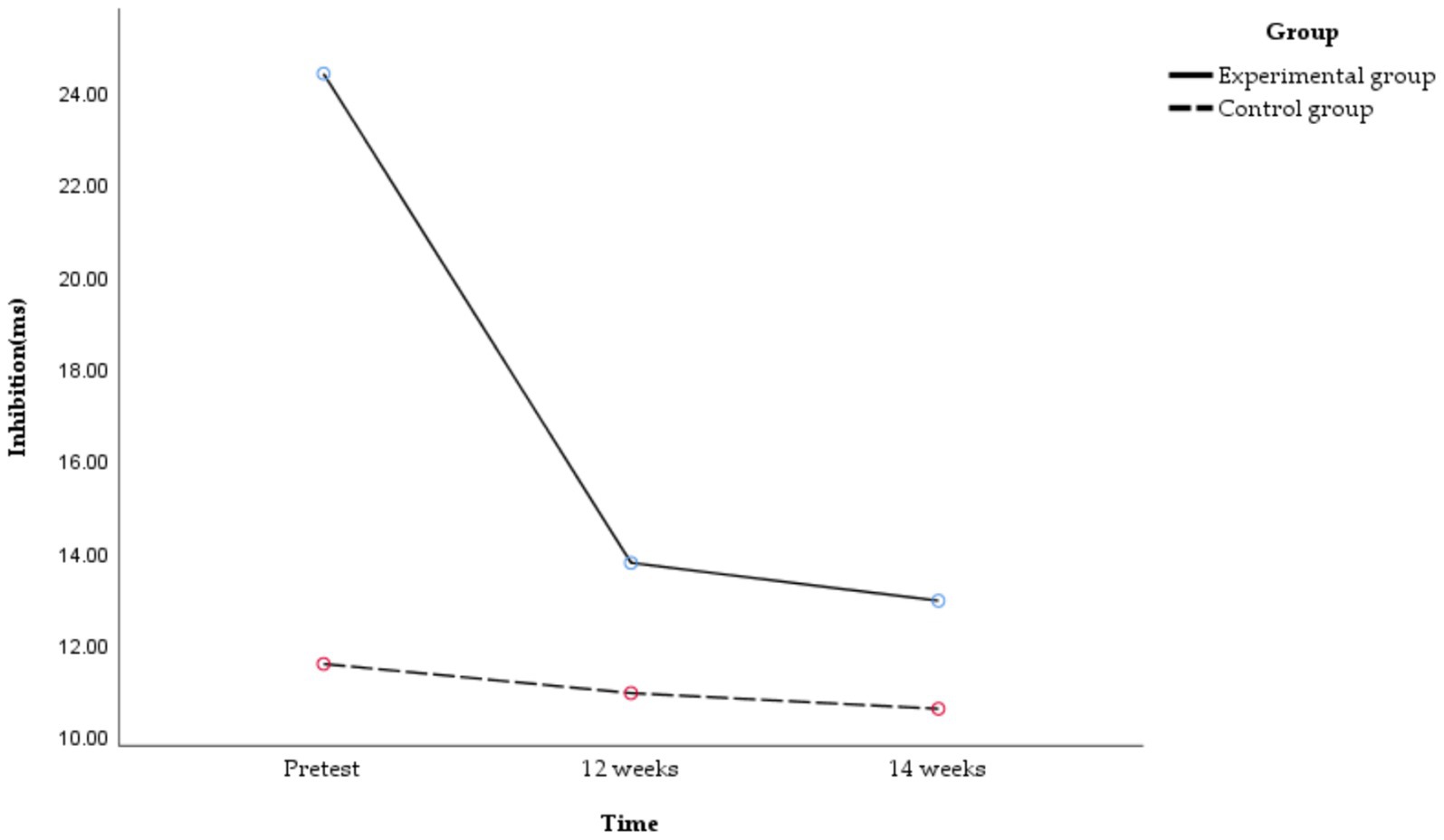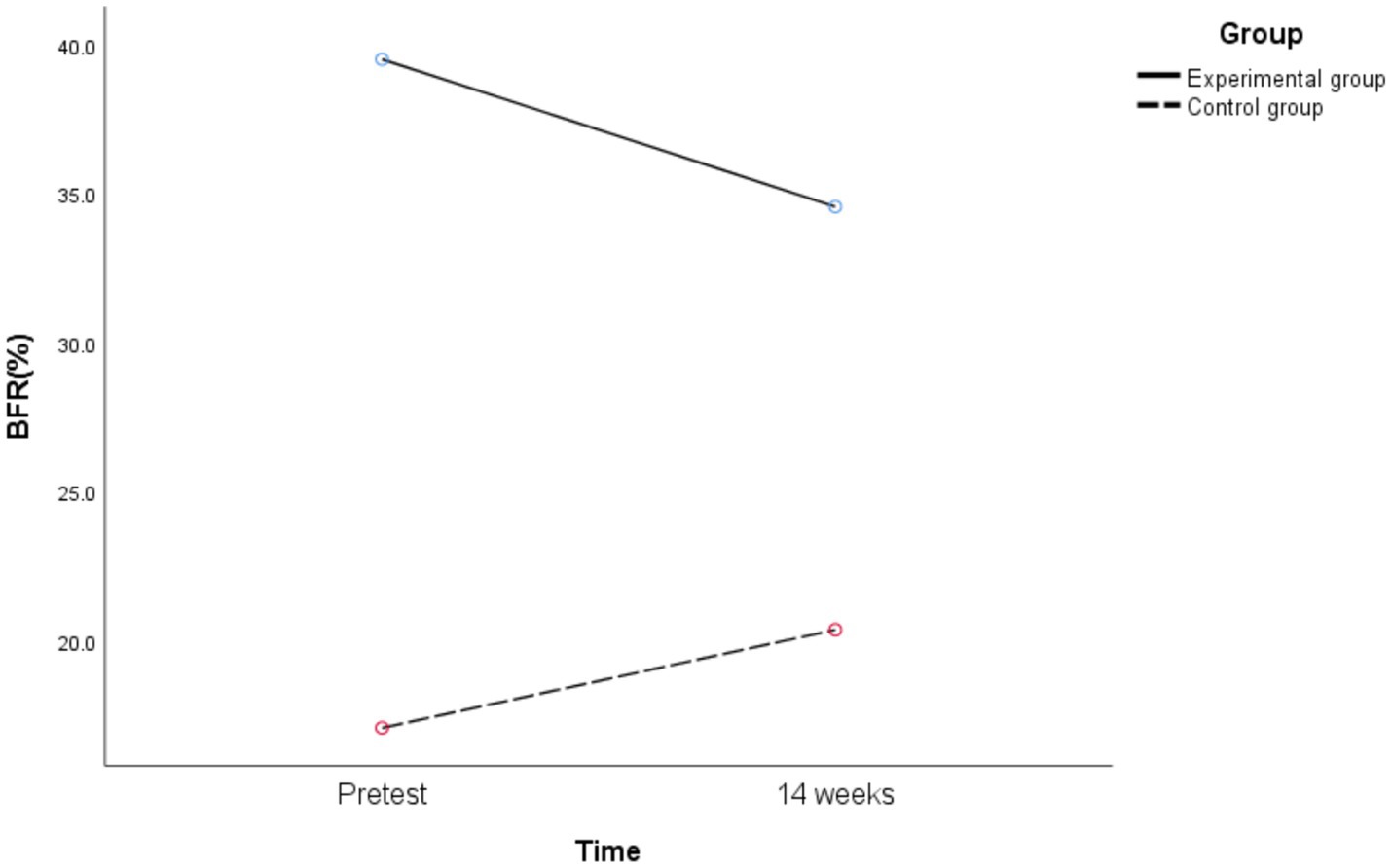- 1College of P.E. and Sports, Beijing Normal University, Beijing, China
- 2Student Affairs Office, China Conservatory of Music, Beijing, China
Objective: This study was to investigate the developmental characteristics of executive function (EF) in obese adolescents and the time-course effects of a 14-week exercise intervention combining aerobic exercise and resistance training on EF in this population.
Methods: The experimental group of 28 obese junior high school students participated in the exercise intervention combining aerobic exercise and resistance training, while the control group of 24 healthy weight junior high school students engaged in the regular recess exercise. EF, including inhibition, working memory, and cognitive flexibility, was assessed 1 week prior to the exercise intervention and at 12 and 14 weeks post-intervention. Changes in EF sub-functions in both groups at different time points during the exercise intervention were analyzed.
Results: The findings revealed that obese junior high school students exhibited lower levels of inhibition (p = 0.003, Cohen’s d = 0.848) and cognitive flexibility (p = 0.013, Cohen’s d = 0.706) compared to their healthy weight peers. The exercise intervention combining aerobic exercise and resistance training led to significant improvements in EF among obese junior high school students, with inhibition (p < 0.01, Cohen’s d = 0.713; p = 0.003, Cohen’s d = 0.683) and cognitive flexibility (p = 0.001, Cohen’s d = 0.797; p < 0.01, Cohen’s d = 0.890) showing significant improvement at 12 and 14 weeks post-intervention, and working memory demonstrating significant improvement at 14 weeks (p = 0.004, Cohen’s d = 0.710). No significant differences were observed in EF over time in healthy weight junior high school students.
Conclusion: Obese adolescents had impaired EF, as evidenced by low levels of the inhibition and cognitive flexibility compared to healthy weight adolescents. The exercise intervention combining aerobic exercise and resistance training had a positive effect on EF of obese adolescents. The time-course effects of the intervention on improvements in inhibition, working memory, and cognitive flexibility varied with intervention duration in obese adolescents, with significant changes in inhibition and cognitive flexibility observed at 12 weeks and significant changes in working memory at 14 weeks.
1 Introduction
Globally, there is a persistent public health concern regarding the high prevalence of overweight and obesity (Douglas et al., 2019; Taghizadeh and Farhangi, 2020; Hestbaek et al., 2021; Karampatsou et al., 2021; Clarke et al., 2022). Adolescents who are obese face adverse effects on their physical fitness and are at an elevated risk of developing chronic conditions such as diabetes and hypertension (Disse and Zimmer, 2014; Gao et al., 2022). Additionally, obesity has been found to have a negative impact on the cognitive function of adolescents (Smith et al., 2011; Bocarsly et al., 2015; Wang et al., 2016; Meo et al., 2019).
One crucial aspect of cognitive function is executive function (EF), which encompasses higher-level cognitive processes that regulate and manage various fundamental cognitive functions during the execution of complex cognitive tasks. EF comprises three sub-functions: inhibition, working memory and cognitive flexibility (Friedman et al., 2006; Diamond, 2012; Chen et al., 2019). Research indicated that obese adolescents exhibit poorer inhibition in EF compared to their healthy weight peers (Yi et al., 2015; Kittel et al., 2017; Mamrot and Hanć, 2019). Therefore, it is imperative to investigate effective strategies to enhance the EF of obese adolescents.
Moreover, prior research has indicated that exercise intervention can enhance physical fitness, motor proficiency, and academic achievement in adolescents with and without disabilities (Davis et al., 2011; Battaglia et al., 2019). These studies have also shown that exercise intervention can enhance EF in both typically developing adolescents and those disabilities who exhibit deficits in EF (Davis et al., 2011; O'Malley, 2011; Audiffren and André, 2019; Lind et al., 2019; Mehren et al., 2019; Schwarck et al., 2019). However, there was a lack of research on exercise intervention targeting EF in obese adolescents, and the progression of changes over time remained unclear. Therefore, this study aimed to investigate the developmental characteristics of EF in obese junior high school students. By focusing on the characteristics of EF, the study implemented a 14-week exercise intervention combining aerobic exercise and resistance training. The exercise intervention was designed based on three key pathways for enhancing EF through exercise: action characteristics, exercise intensity, and exercise scenarios (Pan et al., 2016). The aim of the study was to investigate the effects of exercise intervention on the EF of obese junior high school students, as well as the time-course effects, in order to develop an efficient exercise intervention regimen for enhancing the EF of obese adolescents. The objective of the research was to establish a theoretical foundation and practical guidance for utilizing exercise to enhance the physical and mental well-being of this population. The study hypothesized that obese adolescents exhibit lower EF levels compared to their healthy weight peers, and that exercise intervention can enhance the different sub-functions of EF in obese adolescents, with the effectiveness of improvement varying over time.
2 Materials and methods
2.1 Study design
A hybrid experimental design involving 2 groups (experimental group, control group) × 3 time points (pretest, 12 weeks, 14 weeks) was implemented in this study (Pan et al., 2016).
The experimental group consisted of obese junior high school students who performed an exercise intervention combining aerobic exercise and resistance training. The control group consisted of junior high school students of healthy weight who performed regular recess exercises.
The exercise intervention was administered by professional physical education instructors. Several prior research studies have demonstrated that a 12-week exercise intervention can enhance EF to different extents (Liu, 2017; Meng, 2021; He, 2022). This study aimed to investigate whether a longer duration of exercise intervention can lead to greater improvements in EF. To achieve this, the length of the exercise intervention was extended, and assessments of EF were conducted at both the 12-week and 14-week marks of the intervention period.
2.2 Participants
A priori sample size estimation was conducted using G*Power version 3.1.9.7 (Kang, 2021), with an effect size f of 0.25, α as 0.05, group as 2, number of measures as 2, the sample size was 28.
The obese junior high school students included in this study were selected based on specific criteria. These criteria were: (1) Body Mass Index (BMI): BMI = weight (kg)/height (m)2. BMI screening according to WS/T 586–2018 Screening for overweight and obesity among school-age children and adolescents (National Health and Family Planning Commission, 2018), that is, males were eligible for inclusion if they had a BMI greater than 25.2 kg/m2 at age 13 years and 25.7 kg/m2 at age 13.5 years, and females were eligible for inclusion if they had a BMI greater than 25.0 kg/m2 at age 13 years and 25.6 kg/m2 at age 13.5 years. (2) Body Fat Ratio (BFR): BFR was measured by Bioelectrical Impedance Analysis (BIA) using a Body Composition Analyzer (Brand: TANITA, Model: MC-980MA), and according to WHO guidelines (WHO Expert Committee, 1995; Chusyd et al., 2016; Tomassoni et al., 2020; Iłowiecka et al., 2021), a BFR greater than 25% for males and 35% for females was considered eligible for inclusion. (3) All participants were aged between 13 and 14 years, of normal intelligence, without a history of psychiatric or genetic disorders. They willingly volunteered for the study, provided written informed consent, and their parents were informed and consented to their participation.
In this study, cluster sampling methodology was employed to select participants. Specifically, 28 obese junior high school students were identified from a pool of 170 students, resulting in a detection rate of 16.5%. Additionally, 24 junior high school students with healthy BMI and BFR were chosen randomly to serve as the control group. The group of the experiment was double-blind, ensuring that both the subjects and the individuals administering the exercise intervention were unaware of the group assignments.
The study was carried out following the guidelines outlined in the Declaration of Helsinki, received approval from the Ethics Committee, adhered to the Standards of Ethics in Sport and Exercise Science Research, and was undertaken in partnership with the Laboratory School. The study protocol was registered with the Chinese Clinical Trial Registry at https://www.chictr.org.cn/.
2.3 Materials
The EF was assessed using the E-prime 2.0 system on a computer (Chen et al., 2011a,b). Participants were instructed to provide prompt and precise responses in each task, emphasizing the attainment of proficiency before progressing to the formal assessment. EF evaluations were conducted at three specific intervals: 1 week pre-intervention, 12 weeks post-intervention, and 14 weeks post-intervention. The collection of EF test data was organized by members of the research team.
In the Flanker task, participants were presented with two types of conditions: consistent conditions, where all letters on the screen are the same (e.g., “FFFFF”), and inconsistent conditions, where the middle letter was different from the others (e.g., “FFLFF”), as shown in Figure 1. Each condition was displayed for 1,000 ms with an intermediate interval of 500 ms “+.” The conditions were randomly presented with equal probability during the test, which includes 12 practice trials followed by 48 formal judgments. Test scores were calculated as the mean response time (RT) for inconsistent conditions minus that for consistent conditions, with a smaller difference indicating better inhibition performance.
In the 1-back task, participants were exposed to a series of 26 English letters displayed on a screen. Each letter was shown for a duration of 2,000 ms, with a 3,000 ms interval between consecutive letters. The task required subjects to determine if the current letter matched the preceding one and respond accordingly using a designated key, as illustrated in Figure 2. Prior to the main data collection phase, participants underwent 12 practice trials. The formal task comprised 25 judgment trials. Performance on the task was assessed based on the average RT, with shorter times indicating better working memory capacity.
In the More-odd shifting task, participants were exposed to numerical stimuli, with one number displayed on each screen. Each number was shown for 2,000 ms, with a 3,000 ms interval between different digits. The test comprised three distinct stages. The initial stage involved the presentation of black numbers to assess the relationship between the number and the magnitude of 5. Subsequently, green numbers were displayed in the second stage to evaluate the parity of the numbers (odd or even). In the final stage, a mix of green and black numbers were randomly presented, with participants required to judge magnitude when black numbers appeared and parity when green numbers were shown, as illustrated in Figure 3. The first and second stages each included 8 practice trials and 16 formal judgments, while the third stage encompassed 16 practice trials and 32 formal judgments. Cognitive flexibility was evaluated by measuring the difference in RT, calculated as the average RT of the third stage minus the average RT of the first and second stages. Smaller differences indicated better cognitive flexibility.
2.4 Procedure
Exercise in the experimental and control groups took place at the same time. The experimental group participated in a 40-min exercise intervention combining aerobic exercise and resistance training, while the control group participated in a 40-min regular recess exercises. Both groups engaged in exercise activities during the 50-min morning school recess period. The exercise intervention was centrally administered from September to December.
The multi-path theory, as posited by our research team in the previous period, suggested that the beneficial impact of exercise intervention on EF development can be realized through three pathways (Pan et al., 2016): action characteristics, exercise intensity and exercise scenarios. Action characteristics refer to the technical characteristics of the exercise program, such as the complexity, novelty and relevance of the actions involved. Actions that were intricate, innovative, and purposeful necessitate continual adjustment and adaptation to external stimuli, thereby engaging EF in the brain. This engagement was further enhanced through repetitive training. Exercise intensity encompassed varying levels of exertion, including low, moderate, and high intensity. Research indicated that different intensities of exercise both can enhance EF, with moderate intensity exercise demonstrating the most favorable outcomes (Chen et al., 2014). Exercise scenarios referred to the instructional and learning environment in which individuals engage in physical activity. Movement learning was most effective when situated within a specific context, and the sub-components of EF can be strengthened through the implementation of cooperative, multi-memory point, multi-tasking, and problem-based scenarios.
Based on the above, in the development of an exercise intervention for obese junior high school students, in terms of action characteristics, the difficulty of the actions was gradually increased according to the subjects’ mastery of each motor skill, from single actions to combined actions, from simple to complex actions, and from familiar to unfamiliar actions. In terms of exercise intensity, a subset of participants wore Polar heart rate monitors during each exercise intervention, with average heart rates recorded at specific intervals to ensure moderate intensity levels were maintained. Furthermore, exercise scenarios were tailored to include cooperative, multi-memory point, multi-tasking, and problematic challenges aligned with participants’ preferences, gradually escalating cognitive demands to sustain engagement and enhance EF.
The 14-week exercise intervention program consisted of the following components: (1) Exercise frequency: participants engaged in physical activity 4 times per week. (2) Exercise intensity: participants exercised at a moderate intensity, calculated as (220 minus age) multiplied by 60–69%. (3) Duration of each exercise session: 40 min per session, comprising 5 min of warm-up, 20 min of aerobic exercise, 10 min of resistance training, and 5 min of relaxation exercises. (4) Type of exercise: the intervention included a combination of aerobic exercise and resistance training, with aerobic exercise being the primary focus and resistance training serving as a supplementary component. Aerobic activities included pattern running, aerobic games, and rope ladder training, while resistance training focused on exercises utilizing one’s own body weight to target strength development in the upper limbs, lower limbs, and core muscles.
2.5 Data analysis
SPSS 25.0 (SPSS Inc., Chicago, IL, United States) was used to process and analyze the data, the Independent-samples T test was used to developmentally characterize the EF, BMI and BFR of obese and healthy weight junior high school students, and the repeated-measures ANOVA was used to analyze the separate and interactive effects of two factors of group and time, with statistical analysis significant at p ≤ 0.05. Calculations of “Cohen’s effect size” and “post-hoc power analysis” using G*Power version 3.1.9.7 (Kang, 2021), considering α of 0.05, two groups, and three measurement points.
3 Results
3.1 Monitoring of exercise intensity
In order to accurately control the exercise intensity, 4 obese junior high school students were randomly selected in this study to wear Polar meter to monitor heart rate. Specific methods: 2 male and 2 female students were randomly selected, and 5 heart rate measurements were taken during each exercise intervention, namely: during the quiet time before the intervention, the 10th minute, the 20th minute, the 30th minute, and the 40th minute, and the exercise intensity was monitored according to the average heart rate. As shown in Figure 4, the average heart rate of the 4 randomly selected obese junior high school students in the experimental group during the exercise intervention was 134 beats/min, which reached about 65% of their maximum heart rate; as shown in Figure 5, the overall average heart rate of the 4 randomly selected obese junior high school students during each intervention ranged from 129 to 137 beats/min, which reached the expected moderate intensity of the exercise intervention.
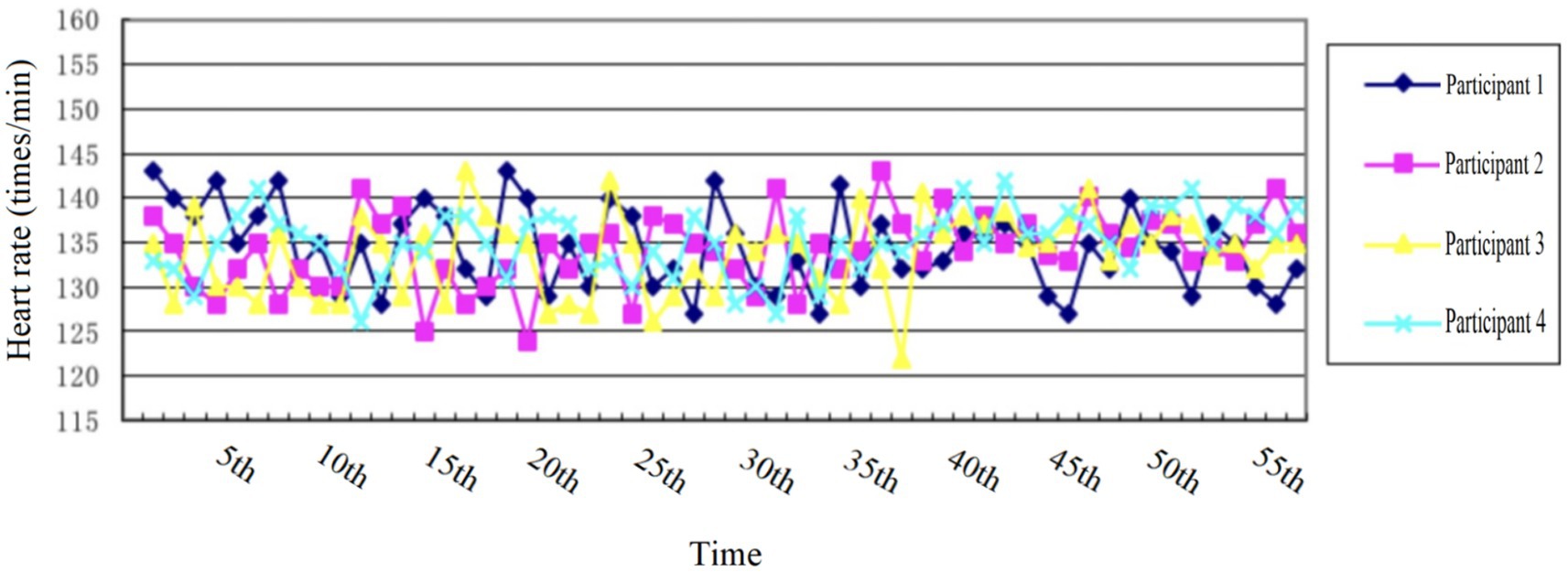
Figure 4. The monitoring figure of the individual average heart rate per activity of 4 obese junior high school students in the experimental group.
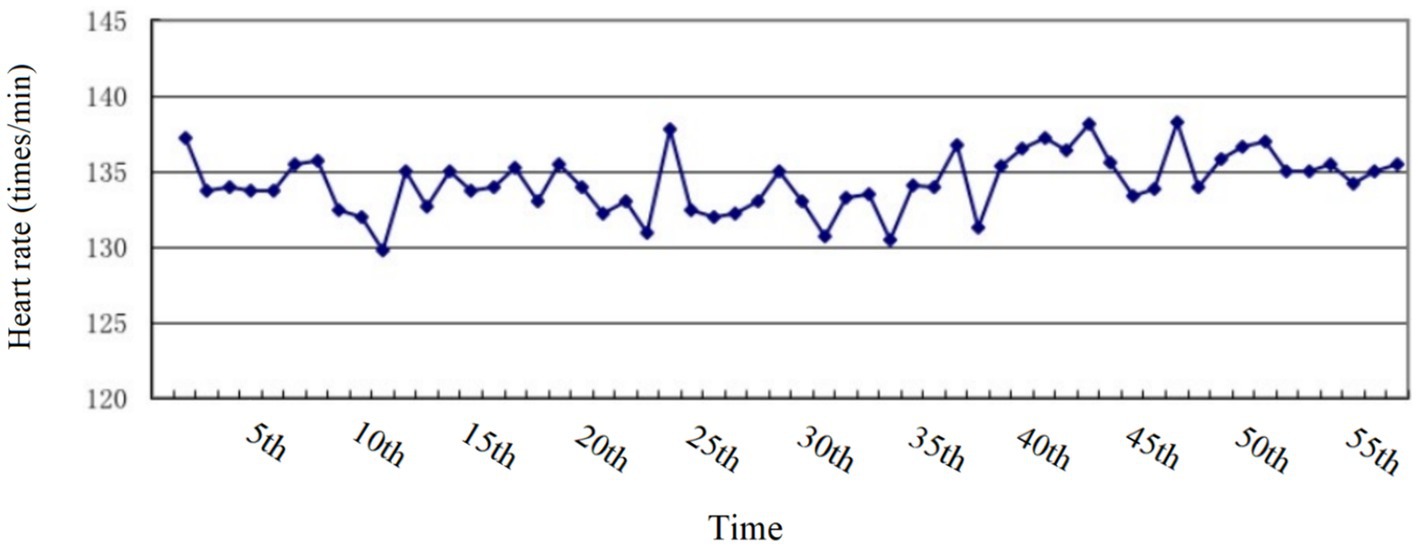
Figure 5. The monitoring figure of the overall average heart rate per activity of 4 obese junior high school students in the experimental group.
3.2 Developmental characteristics of EF in obese junior high school students
To investigate the developmental characteristics of EF in obese junior high school students, pretest data on EF performanced in obese and healthy weight junior high school students were analyzed using Independent-samples T-tests. The results revealed that obese junior high school students had longer average RT for EF tasks compared to their healthy weight peers. Specifically, the RT for inhibition in obese junior high school students was significantly higher [t(50) = 3.069, p = 0.003, Cohen’s d = 0.848] than in healthy weight peers. Additionally, the RT of cognitive flexibility in obese junior high school students was also significantly higher [t(50) = 2.600, p = 0.013, Cohen’s d = 0.706] than in healthy weight peers. However, no significant difference was observed in working memory [t(50) = 1.047, p = 0.300, Cohen’s d = 0.292]. These results indicated that obese junior high school students may have lower EF levels than their healthy weight peers, particularly in the areas of inhibition and cognitive flexibility (see Table 1).

Table 1. Results of the Independent-samples T-test for developmental characteristics of EF in obese and healthy weight junior high school students (M ± SD).
3.3 Effects of exercise intervention on EF in obese junior high school students and characteristics of time-course changes
3.3.1 Results of inhibition
The results revealed that the main effect of time on inhibition was significant [F(2,100) = 5.181, p = 0.01, η2p = 0.094], indicating a trend of change in inhibition over time. The main effect of group on inhibition was significant [F(1,50) = 5.203, p = 0.027, η2p = 0.094], indicating a significant difference in inhibition between the experimental and control groups. The interaction effect of time * group was also significant [F(2,100) = 3.848, p = 0.03, η2p = 0.071], indicating a significant difference in the change in inhibition between the experimental and control groups at different time points (see Table 2).

Table 2. ANOVA results on the effect of exercise intervention on inhibition in obese junior high school students.
A subsequent analysis of simple effects was conducted, and the following results are shown in Figure 6.
There were significant differences in inhibition at different time points in the experimental group [F(2,49) = 10.998, p < 0.01, η2p = 0.310]. The inhibition of the experimental group at 12 [t(27) = 3.774, p < 0.01, Cohen’s d = 0.713] and 14 weeks [t(27) = 3.613, p = 0.003, Cohen’s d = 0.683] were significantly better than the pretest, but there was no significant difference between 12 and 14 weeks [t(27) = 0.327, p = 0.99, Cohen’s d = 0.153]. The time-course effect of inhibition showed that 14 and 12 weeks > pretest. That is, the 14-week exercise intervention combining aerobic exercise and resistance training could improve the inhibition of obese junior high school students, and the effect remained stable with the increase in exercise intervention time. Conversely, no significant differences in inhibition were observed across the three time points in the control group [F(2,49) = 0.045, p = 0.956, η2p = 0.002].
There was a significant difference between obese and healthy weight junior high school students in inhibition at pretest [F(1,50) = 9.416, p = 0.003, η2p = 0.158], and there was no significant difference in inhibition at 12 [F(1,50) = 0.883, p = 0.352, η2p = 0.017] or 14 weeks [F(1,50) = 0.444, p = 0.508, η2p = 0.009]. That is, before the exercise intervention, the inhibition of healthy weight junior high school students was better than that of obese peers. After the exercise intervention, the inhibition of obese junior high school students aligned with that of healthy weight peers across all assessment time points.
A post hoc power analysis was conducted using G*Power version 3.1.9.7 (Kang, 2021), with an effect size f of 0.276 (partial η2 as 0.071), α as 0.05, group as 2, number of measurements as 3, and correlation as 0.228. Within our selected total sample size, the power (1-β) was approximately 0.994.
3.3.2 Results of working memory
The results revealed that the main effect of time on working memory was significant [F(2,100) = 3.669, p = 0.039, η2p = 0.068], indicating a trend of change in working memory over time. Conversely, no significant difference was observed in the main effect of group on working memory [F(1,50) = 0.298, p = 0.588, η2p = 0.006], and the time * group interaction was also non-significant [F(2,100) = 1.181, p = 0.304, η2p = 0.023] (see Table 3).

Table 3. ANOVA results on the effect of exercise intervention on working memory in obese junior high school students.
A subsequent analysis of simple effects was conducted, and the following results are shown in Figure 7.
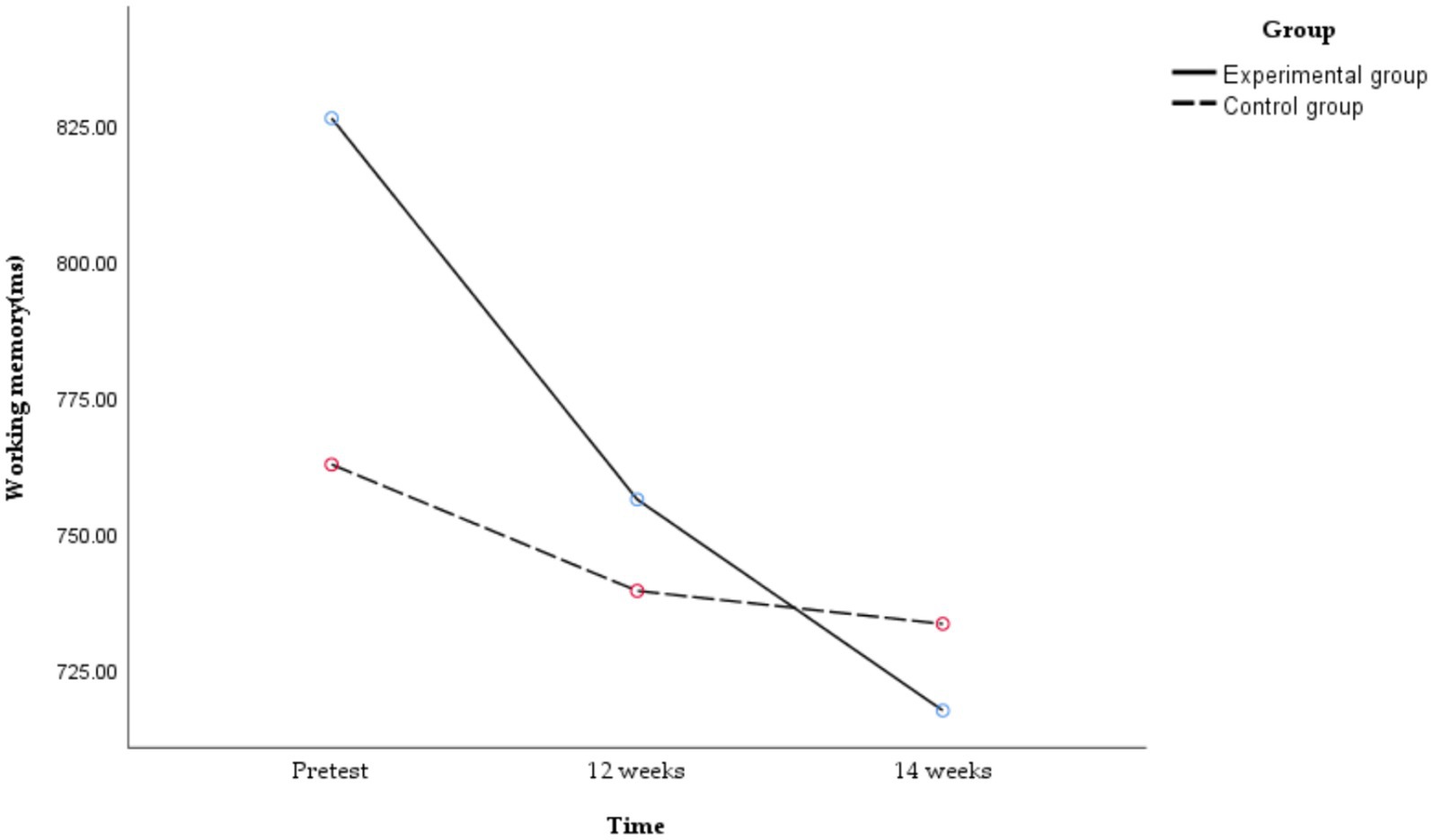
Figure 7. Temporal changes in working memory in obese and healthy weight junior high school students.
There were significant differences in working memory at different time points in the experimental group [F(2,49) = 6.403, p = 0.003, η2p = 0.207]. The working memory of the experimental group at 14 weeks was significantly better than that at the pretest [t(27) = 3.756, p = 0.004, Cohen’s d = 0.710], but there was no significant difference between 12 weeks and the pretest [t(27) = 1.775, p = 0.296, Cohen’s d = 0.336] and no significant difference between 12 and 14 weeks [t(27) = 1.473, p = 0.469, Cohen’s d = 0.664]. The time-course effect of working memory showed that 14 weeks > 12 weeks, pretest. That is, the 14-week exercise intervention combining aerobic exercise and resistance training could improve the working memory of obese junior high school students, with a longer exercise intervention time correlating with better improvement of working memory. Conversely, no significant differences in working memory were observed across the three time points in the control group [F(2,49) = 0.364, p = 0.697, η2p = 0.015].
A post hoc power analysis was conducted using G*Power version 3.1.9.7 (Kang, 2021), with an effect size f of 0.153 (partial η2 as 0.023), α as 0.05, group as 2, number of measurements as 3, and correlation as 0.619. Within our selected total sample size, the power (1-β) was approximately 0.661.
3.3.3 Results of cognitive flexibility
The results revealed that the main effect of time was significant [F(2,100) = 12.242, p < 0.01, η2p = 0.197], indicating a trend of change in cognitive flexibility over time. The interaction effect of time * group was also significant [F(2,100) = 3.913, p = 0.023, η2p = 0.073], indicating a significant difference in the change in cognitive flexibility between the experimental and control groups at different time points. Conversely, the group main effect was not significant [F(1,50) = 2.164, p = 0.148, η2p = 0.041] (see Table 4).

Table 4. ANOVA results on the effect of exercise intervention on cognitive flexibility in obese junior high school students.
A subsequent analysis of simple effects was conducted, and the following results are shown in Figure 8.
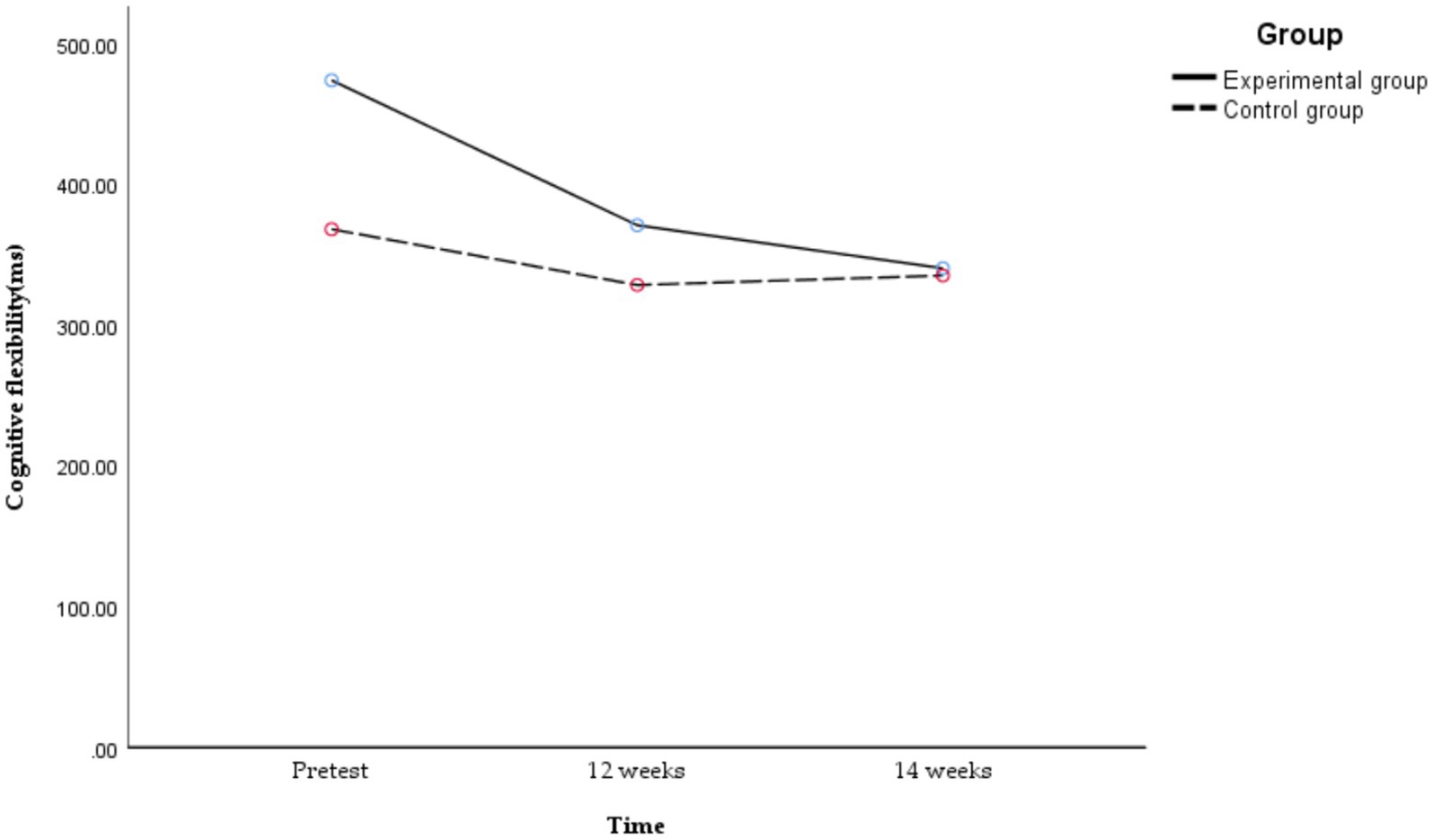
Figure 8. Temporal changes in cognitive flexibility in obese and healthy weight junior high school students.
There were significant differences in cognitive flexibility at different time points in the experimental group [F(2,49) = 14.160, p < 0.01, η2p = 0.366]. The cognitive flexibility of the experimental group at 12 [t(27) = 4.217, p = 0.001, Cohen’s d = 0.797] and 14 weeks were significantly better than the pretest [t(27) = 4.714, p < 0.01, Cohen’s d = 0.890], but there was no significant difference between 12 and 14 weeks [t(27) = 1.900, p = 0.416, Cohen’s d = 0.359]. The time-course effect of cognitive flexibility showed that 14 and 12 weeks > pretest. That is, the 14-week exercise intervention combining aerobic exercise and resistance training could improve the cognitive flexibility of obese junior high school students, and the effect remained stable with the increase in exercise intervention time. Conversely, no significant differences in cognitive flexibility were observed across the three time points in the control group [F(2,49) = 0.985, p = 0.381, η2p = 0.039].
There was a significant difference between obese and healthy weight junior high school students in cognitive flexibility at pretest [F(2,100) = 6.14, p = 0.017, η2p = 0.109], and there was no significant difference in cognitive flexibility at 12 [F(2,100) = 1.18, p = 0.282, η2p = 0.023] or 14 weeks [F(2,100) = 0.02, p = 0.898, η2p = 0.000]. That is, before the exercise intervention, the cognitive flexibility of healthy weight junior high school students was better than that of obese peers. After the exercise intervention, the cognitive flexibility of obese junior high school students aligned with that of healthy weight peers across all assessment time points.
A post hoc power analysis was conducted using G*Power version 3.1.9.7 (Kang, 2021), with an Effect size f of 0.281 (partial η2 as 0.073), α as 0.05, group as 2, number of measurements as 3, and correlation as 0.581. Within our selected total sample size, the power (1-β) was approximately 0.995.
3.4 Effects of exercise intervention on BMI and BFR of obese junior high school students
3.4.1 Comparison of BMI and BFR between obese junior high school students and healthy weight junior high school students
To investigate the difference of BMI and BFR between obese and healthy weight junior high school students, the Independent-samples T-test was conducted for BMI and BFR of the pretests. The results revealed that the BMI [t(50) = 16.527, p < 0.01, Cohen’s d = 4.606] and BFR [t(50) = 13.537, p < 0.01, Cohen’s d = 3.781] of obese junior high school students were higher than those of healthy peers, and the difference was significant. That is, the BMI and BFR of obese junior high school students were significantly higher than those of healthy weigh peers (see Table 5).
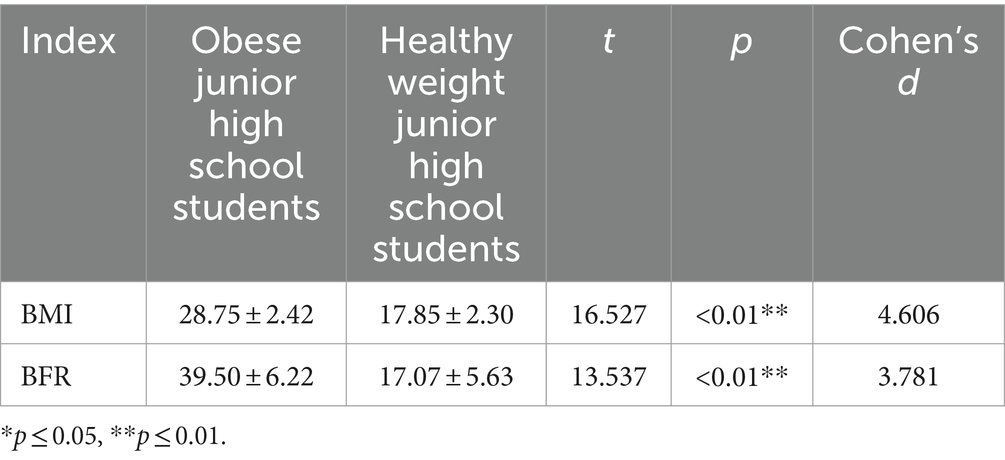
Table 5. Results of the independent-samples T-test of BMI and BFR in obese and healthy weight junior high school students (M ± SD).
3.4.2 Effects of exercise intervention on BMI of obese junior high school students
The repeated-measures ANOVA was used with the following results to analyze the effects of the exercise intervention on BMI in obese junior high school students.
The results revealed that the main effect of time on BMI was nearly significant [F(1,50) = 3.998, p = 0.051, η2p = 0.074], indicating a trend of change in BMI over time. The main effect of group on BMI was significant [F(1,50) = 216.342, p < 0.01, η2p = 0.812], indicating a significant difference in BMI between the experimental and control groups. The interaction effect of time * group was also significant [F(1,50) = 23.988, p < 0.01, η2p = 0.324], indicating a significant difference in the change in BMI between the experimental and control groups at pretest and 14 weeks (see Table 6).

Table 6. ANOVA results on the effect of exercise intervention on BMI in obese junior high school students.
Further simple effects analysis was performed, and the following results are shown in Figure 9.
The 14 weeks BMI of obese junior high school students in the experimental group was significantly different from the pretest [t(27) = 4.312, p < 0.01, Cohen’s d = 0.815], while the 14 weeks BMI of healthy weight junior high school students in the control group was significantly different from the pretest [t(23) = −2.670, p = 0.014, Cohen’s d = 0.545]. That is, the 14-week of exercise intervention combining aerobic exercise and resistance training can improve the BMI of obese junior high school students, while the BMI of healthy weight junior high school students has an upward trend.
There was a significant difference between the experimental group and the control group in BMI at pretest [F(1,50) = 273.13, p < 0.01, η2p = 0.845], and there was also a significant difference in BMI at 14 weeks [F(1,50) = 126.14, p < 0.01, η2p = 0.716]. That is, before exercise intervention, the BMI of healthy weight junior high school students in the control group was better than that of obese junior high school students in the experimental group. After exercise intervention, the BMI of healthy weight junior high school students in the control group was still better than that of obese junior high school students in the experimental group.
3.4.3 Effects of exercise intervention on BFR of obese junior high school students
The repeated-measures ANOVA was used with the following results to analyze the effects of the exercise intervention on BFR in obese junior high school students.
The results revealed that the main effect of time on BFR was significant [F(1,50) = 17.617, p = 0.046, η2p = 0.077], indicating a trend of change in BFR over time. The main effect of group on BFR was significant [F(1,50) = 138.144, p < 0.01, η2p = 0.734], indicating a significant difference in BFR between the experimental and control groups. The interaction effect of time * group was also significant [F(1,50) = 438.140, p < 0.01, η2p = 0.675], indicating a significant difference in BFR between the experimental and control groups at pretest and 14 weeks (see Table 7).

Table 7. ANOVA results on the effect of exercise intervention on BFR in obese junior high school students.
Further simple effects analysis was performed, and the following results are shown in Figure 10.
The 14 weeks BFR of obese junior high school students in the experimental group was significantly different from the pretest [t(27) = 8.910, p < 0.01, Cohen’s d = 1.685], while the 14 weeks BFR of healthy weight junior high school students in the control group was significantly different from the pretest [t(23) = −5.625, p < 0.01, Cohen’s d = 1.146]. That is, the 14-week exercise intervention combining aerobic exercise and resistance training can improve the BFR of obese junior high school students, while the BFR of healthy weight junior high school students has an upward trend.
There was a significant difference between the experimental group and the control group in BFR at pretest [F(1,50) = 183.257, p < 0.01, η2p = 0.786], and there was also a significant difference in BFR at 14 weeks [F(1,50) = 82.72, p < 0.01, η2p = 0.623]. That is, before exercise intervention, the BFR of healthy weight junior high school students in the control group was better than that of obese junior high school students in the experimental group. After exercise intervention, the BFR of healthy weight junior high school students in the control group was still better than that of obese junior high school students in the experimental group.
4 Discussion
4.1 Analysis of the developmental characteristics of EF in obese junior high school students
This study supported the hypothesis that obese adolescents exhibit impaired EF compared to their healthy weight peers, particularly in inhibition and cognitive flexibility. These findings aligned with previous research demonstrating similar findings in obese adolescents. Gentier et al. (2013) found EF impairment and motor perception dysfunction in obese children compared to healthy weight children, and Martí-Nicolovius (2022) found deficits in cognitive function in obese children and adolescents, further highlighting the pervasive impact of obesity on cognitive abilities.
The physiological mechanisms behind the poor development of EF in obese junior high school students may be that obese people have a high fat content, which leads to a significant reduction in cerebral blood flow and speed, insufficient blood supply to the brain, and a decrease in blood oxygen saturation, which affects their brain metabolic processes (Ebbeling et al., 2002; Guo and Chen, 2015). In terms of brain mechanisms, obese people have reduced volume and functional connectivity in brain areas related to EF (Willette and Kapogiannis, 2015), resulting in damage to the wiring system connecting the information processing areas of the brain, which in turn hinders the transmission of signals, leading to slow thinking and slow response, which negatively affects the development of EF.
The implications of our findings were profound, indicating that the compromised EF in obese adolescents could have broader consequences for their overall health and well-being. Given the pivotal role of EF in academic achievement and social adaptation, addressing this issue was not only crucial for the students’ immediate cognitive development but also for their long-term success and mental health. This study thus called for the development and implementation of targeted interventions aimed at enhancing EF in obese adolescents.
4.2 Time-course effects of exercise intervention combining aerobic exercise with resistance training on EF in obese junior high school students
This study supported the hypothesis that exercise intervention combining aerobic exercise with resistance training can significantly enhances EF in obese adolescents. These findings aligned with previous research indicating the cognitive benefits of both aerobic and resistance training for obese adolescents (Guo et al., 2016). However, this study stood out by adopting an innovative approach that combines these two exercise modalities, focusing on three key pathways—action characteristics, exercise intensity, and exercise scenarios—to optimize EF improvement. The selection of complex, novel, and targeted actions, adjusted dynamically to the external environment, along with moderate-intensity exercise and diverse scenarios, constituted the unique aspect of our intervention. This multifaceted approach effectively improved EF in obese adolescents.
Beyond the three key pathways, the physiological mechanisms underlying our exercise intervention’ s efficacy in improving EF warrant attention. Long-term aerobic exercise combined with resistance training intervention successfully reduced fat content, enhanced blood circulation, and improved blood oxygen saturation in obese junior high school students. These physiological changes activated brain regions and functional connectivity associated with EF, as well as enhanced hippocampal insulin signaling and neuroplasticity (Chen et al., 2011a,b; Guo et al., 2016; Park et al., 2019). These findings contributed to the understanding of how combined exercise interventions can specifically target and improve EF in obese adolescents.
Utilizing a multi-time-point measurement design, our study uniquely explored the time-course effects of the exercise intervention on the three sub-functions of EF: inhibition, working memory, and cognitive flexibility. Our results indicated that different intervention cycles had selective positive effects on these sub-functions. Notably, inhibition and cognitive flexibility significantly improved at 12 weeks, while working memory significantly improved at 14 weeks. These findings build upon Yin et al.’s (2014) study, suggested that longer intervention durations may yield better EF outcomes. This study underscored the importance of identifying optimal time points for significant EF changes.
Throughout the exercise intervention, participants engaged in continuous inhibition of dominant responses and conscious muscle control during resistance training, which likely contributed to the significant improvements in inhibition. Cognitive flexibility was enhanced through the need for constant movement transitions in response to changing exercise commands and rules. Working memory improvement was attributed to the participants’ requirement to memorize movements and game rules, and responded quickly in dynamic situations. Our focus on improving inhibition and cognitive flexibility, areas typically weaker in obese students compared to their healthy weight peers, may explained the earlier observed changes in these sub-functions. This targeted approach to exercise intervention design represents a novel strategy for optimizing EF development in obese adolescents.
4.3 The strengths and the limitations of this study
This study’s novel contribution lied in the specific focus on the time-course effects of the exercise intervention. This provided valuable insights into the optimal timing and duration of exercise interventions for EF development in obese adolescents. Additionally, the combination of aerobic exercise and resistance training, along with the multifaceted approach incorporating action complexity and diverse exercise scenarios, offered a unique perspective on the potential mechanisms underlying the observed improvements. In addition, the health implications of this study were significant. Improved EF can enhance academic performance, social interactions, and overall cognitive functioning, ultimately improving the quality of life for obese adolescents. This study provided evidence supporting the potential of exercise as a non-pharmacological intervention for improving cognitive function and overall health in obese adolescents.
Despite its strengths, this study had limitations. The relatively shorted duration of the intervention and limited number of time points for EF measurements warrant further research exploring the long-term effects of exercise on the development of EF in obese adolescents as well as the late effects. Additionally, increasing the sample size and incorporating brain imaging techniques could provide valuable insights into the neural mechanisms underlying the observed improvements. Future research could also explored the impact of exercise on other cognitive functions, such as attention and memory, in obese adolescents. Additionally, investigating the effectiveness of targeted exercise interventions for different sports could provide valuable insights into the optimal exercise prescription for improving EF in obese adolescents.
5 Conclusion
Obese adolescents had impaired EF, as evidenced by low levels of the inhibition and cognitive flexibility compared to healthy weight adolescents. The exercise intervention combining aerobic exercise and resistance training had a positive effect on EF of obese adolescents. The time-course effects of the intervention on improvements in inhibition, working memory, and cognitive flexibility varied with intervention duration in obese adolescents, with significant changes in inhibition and cognitive flexibility observed at 12 weeks and significant changes in working memory at 14 weeks.
Data availability statement
The original contributions presented in the study are included in the article/supplementary material, further inquiries can be directed to the corresponding authors.
Ethics statement
The studies involving humans were approved by the institutional review board of the National Key Laboratory of Cognitive Neuroscience and Learning. The studies were conducted in accordance with the local legislation and institutional requirements. Written informed consent for participation in this study was provided by the participants’ legal guardians/next of kin.
Author contributions
LH: Writing – original draft. QS: Writing – original draft. HY: Writing – original draft. LC: Writing – original draft.
Funding
The author(s) declare that financial support was received for the research, authorship, and/or publication of this article. This study were funded by the STI 2030—Major Projects, grant number 2021ZD0200500 and the Beijing Social Sciences Fund, grant number 22YTC035.
Acknowledgments
We thank a junior high school in Chaoyang District, Beijing, China, for helping with the experimental intervention.
Conflict of interest
The authors declare that the research was conducted in the absence of any commercial or financial relationships that could be construed as a potential conflict of interest.
Publisher’s note
All claims expressed in this article are solely those of the authors and do not necessarily represent those of their affiliated organizations, or those of the publisher, the editors and the reviewers. Any product that may be evaluated in this article, or claim that may be made by its manufacturer, is not guaranteed or endorsed by the publisher.
References
Audiffren, M., and André, N. (2019). The exercise–cognition relationship: a virtuous circle. J. Sport Health Sci. 8, 339–347. doi: 10.1016/j.jshs.2019.03.001
Battaglia, G., Agrò, G., Cataldo, P., Palma, A., and Alesi, M. (2019). Influence of a specific aquatic program on social and gross motor skills in adolescents with autism Spectrum disorders: three case reports. J Funct Morphol Kinesiol. 4:27. doi: 10.3390/jfmk4020027
Bocarsly, M. E., Fasolino, M., Kane, G. A., LaMarca, E. A., Kirschen, G. W., Karatsoreos, I. N., et al. (2015). Obesity diminishes synaptic markers, alters microglial morphology, and impairs cognitive function. Proc. Natl. Acad. Sci. 112, 15731–15736. doi: 10.1073/pnas.1511593112
Chen, Y., Spagna, A., Wu, T., Kim, T. H., Wu, Q., Chen, C., et al. (2019). Testing a cognitive control model of human intelligence. Sci. Rep. 9:2898. doi: 10.1038/s41598-019-39685-2
Chen, A. G., Yin, H. C., Wang, J., Li, X. N., and Song, Z. (2011a). Magnetic resonance imaging study on the improvement of executive function in children with short moderate-intensity aerobic exercise. China Sport Sci. 31, 35–40. doi: 10.16469/j.css.2011.10.005
Chen, A. G., Yin, H. C., Yan, J., and Yang, Y. (2011b). Effect of different intensity short time aerobic exercise on executive function. Acta Psychol. Sin. 43, 1055–1062. doi: 10.3724/SP.J.1041.2011.01055
Chen, A. G., Zhao, L., Li, H. Y., Yan, J., and Yin, H. C. (2014). Effects of acute basketball dribbling training of different intensity on executive function of primary students. J. Tianjin Univ. Sport 29, 352–355. doi: 10.13297/j.cnki.issn1005-0000.2014.04.015
Chusyd, D. E., Wang, D., Huffman, D. M., and Nagy, T. R. (2016). Relationships between rodent white adipose fat pads and human white adipose fat depots. Front. Nutr. 3:10. doi: 10.3389/fnut.2016.00010
Clarke, M., Mathew, S. M., Giles, L. C., Pena, A. S., Barr, I. G., Richmond, P. C., et al. (2022). A prospective study investigating the impact of obesity on the immune response to the quadrivalent influenza vaccine in children and adolescents. Vaccines 10:699. doi: 10.3390/vaccines10050699
Davis, C. L., Tomporowski, P. D., McDowell, J. E., Austin, B. P., Miller, P. H., Yanasak, N. E., et al. (2011). Exercise improves executive function and achievement and alters brain activation in overweight children: a randomized, controlled trial. Health Psychol. 30, 91–98. doi: 10.1037/a0021766
Diamond, A. (2012). Executive functions. Annu. Rev. Psychol. 173, 135–168. doi: 10.1016/B978-0-444-64150-2.00020-4
Disse, S., and Zimmer, K. P. (2014). Obesity in children – a chronic disease? Dtsch. Arztebl. Int. 111, 816–817. doi: 10.3238/arztebl.2014.0816
Douglas, S. M., Byers, A. W., and Leidy, H. J. (2019). Habitual breakfast patterns do not influence appetite and satiety responses in Normal vs. high-protein breakfasts in overweight adolescent girls. Nutrients 11:223. doi: 10.3390/nu11061223
Ebbeling, C. B., Pawlak, D. B., and Ludwig, D. S. (2002). Childhood obesity: public-health crisis, common sense cure. Lancet 360, 473–482. doi: 10.1016/S0140-6736(02)09678-2
Friedman, N. P., Miyake, A., Corley, R. P., Young, S. E., Defries, J. C., and Hewitt, J. K. (2006). Not all executive functions are related to intelligence. Psychol. Sci. 17, 172–179. doi: 10.1111/j.1467-9280.2006.01681.x
Gao, J., Lu, Y., Gokulnath, P., Vulugundam, G., Li, G., Li, J., et al. (2022). Benefits of physical activity on cardiometabolic diseases in obese children and adolescents. J Transl Int Med. 10, 236–245. doi: 10.2478/jtim-2022-0041
Gentier, I., Augustijn, M., Deforche, B., Tanghe, A., De Bourdeaudhuij, I., Lenoir, M., et al. (2013). A comparative study of performance in simple and choice reaction time tasks between obese and healthy weight children. Res. Dev. Disabil. 34, 2635–2641. doi: 10.1016/j.ridd.2013.04.016
Guo, Y. P., and Chen, P. (2015). The positive effect of the comprehensive intervention of aerobic exercise on the cognitive function of obese children: exploration of 1H-MRS and event-related potential studies. China Sport Sci. Technol. 51, 79–85. doi: 10.16470/j.csst.201504011
Guo, Y. H., Zhao, Y. J., Hao, Z. Y., and Chen, P. (2016). Study on attention cognition of children with moderate to severe obesity by comprehensive intervention of exercise and diet. Bull. Sci. Technol. 32, 80–83. doi: 10.13774/j.cnki.kjtb.2016.04.017
He, J. (2022). Effects of 12 week Wuqinxi intervention on executive function in patients with Parkinson's disease. [dissertation’ s thesis]. Shanghai: Shanghai University of Sport.
Hestbaek, L., Aartun, E., Côté, P., and Hartvigsen, J. (2021). Spinal pain increases the risk of becoming overweight in Danish schoolchildren. Sci. Rep. 11:10235. doi: 10.1038/s41598-021-89595-5
Iłowiecka, K., Glibowski, P., Skrzypek, M., and Styk, W. (2021). The long-term dietitian and psychological support of obese patients who have reduced their weight allows them to maintain the effects. Nutrients 13:2020. doi: 10.3390/nu13062020
Kang, H. (2021). Sample size determination and power analysis using the G*power software. J. Educ. Eval. Health Prof. 18:17. doi: 10.3352/jeehp.2021.18.17
Karampatsou, S. I., Genitsaridi, S. M., Michos, A., Kourkouni, E., Kourlaba, G., Kassari, P., et al. (2021). The effect of a life-style intervention program of diet and exercise on irisin and FGF-21 concentrations in children and adolescents with overweight and obesity. Nutrients 13:1274. doi: 10.3390/nu13041274
Kittel, R., Schmidt, R., and Hilbert, A. (2017). Executive functions in adolescents with binge-eating disorder and obesity. Int. J. Eat. Disord. 50, 933–941. doi: 10.1002/eat.22714
Lind, R. R., Beck, M. M., Wikman, J., Malarski, K., Krustrup, P., Lundbye-Jensen, J., et al. (2019). Acute high-intensity football games can improve children's inhibitory control and neurophysiological measures of attention. Scand. J. Med. Sci. Sports 29, 1546–1562. doi: 10.1111/sms.13485
Liu, J. Y. (2017). “Dosage effect” of the relationship between aerobic exercise and college Students' executive function. J. Beijing Sport Univ. 40, 58–64. doi: 10.19582/j.cnki.11-3785/g8.2017.01.010
Mamrot, P., and Hanć, T. (2019). The association of the executive functions with overweight and obesity indicators in children and adolescents: a literature review. Neurosci. Biobehav. Rev. 107, 59–68. doi: 10.1016/j.neubiorev.2019.08.021
Martí-Nicolovius, M. (2022). Effects of overweight and obesity on cognitive functions of children and adolescents. J. Neurol. 75, 59–65. doi: 10.33588/rn.7503.2022173
Mehren, A., Özyurt, J., Thiel, C. M., Brandes, M., Lam, A. P., and Philipsen, A. (2019). Effects of acute aerobic exercise on response inhibition in adult patients with ADHD. Sci. Rep. 9:19884. doi: 10.1038/s41598-019-56332-y
Meng, X. X. (2021). The effect of 12 weeks of moderate to vigorous intensity rope skipping on executive function in preschool children. [dissertation’s thesis]. Shanghai: Shanghai University of Sport.
Meo, S. A., Altuwaym, A. A., Alfallaj, R. M., Alduraibi, K. A., Alhamoudi, A. M., Alghamdi, S. M., et al. (2019). Effect of obesity on cognitive function among school adolescents: a cross-sectional study. Obes. Facts 12, 150–156. doi: 10.1159/000499386
National Health and Family Planning Commission (2018). WS/T 586–2018 screening for overweight and obesity among school-age children and adolescents[S]. Beijing: China Standards Press.
O'Malley, G. (2011). Aerobic exercise enhances executive function and academic achievement in sedentary, overweight children aged 7-11 years. J. Physiother. 57:255. doi: 10.1016/S1836-9553(11)70056-X
Pan, J. L., Yin, H. C., Chen, A. G., Wang, Y., Cui, L., and Cui, Y. B. (2016). An experimental study on the effect of exercise intervention on executive function of primary school students with mathematics learning difficulties. Chin. J. Spec. Educ. 191, 54–62.
Park, H. S., Park, S. S., Kim, C. J., Shin, M. S., and Kim, T. W. (2019). Exercise alleviates cognitive functions by enhancing hippocampal insulin Signaling and neuroplasticity in high-fat diet-induced obesity. Nutrients 11:1603. doi: 10.3390/nu11071603
Schwarck, S., Schmicker, M., Dordevic, M., Rehfeld, K., Müller, N., and Müller, P. (2019). Inter-individual differences in cognitive response to a single bout of physical exercise—a randomized controlled cross-over study. J. Clin. Med. 8:1101. doi: 10.3390/jcm8081101
Smith, E., Hay, P., Campbell, L., and Trollor, J. N. (2011). A review of the association between obesity and cognitive function across the lifespan: implications for novel approaches to prevention and treatment. Obes. Rev. 12, 740–755. doi: 10.1111/j.1467-789X.2011.00920.x
Taghizadeh, S., and Farhangi, M. A. (2020). The effectiveness of pediatric obesity prevention policies: a comprehensive systematic review and dose-response meta-analysis of controlled clinical trials. J. Transl. Med. 18:480. doi: 10.1186/s12967-020-02640-1
Tomassoni, D., Martinelli, I., Moruzzi, M., Di Bonaventura, M. V. M., Cifani, C., Amenta, F., et al. (2020). Obesity and age-related changes in the brain of the Zucker Leprfa/fa rats. Nutrients 12:1356. doi: 10.3390/nu12051356
Wang, C., Chan, J. S., Ren, L., and Yan, J. H. (2016). Obesity reduces cognitive and motor functions across the lifespan. Neural Plast. 2016, 2473081–2473013. doi: 10.1155/2016/2473081
WHO Expert Committee (1995). Physical status: the use of and interpretation of anthropometry, report of a WHO expert committee. Geneva, Switzerland: World Health Organization, vol. 854, 1–452.
Willette, A. A., and Kapogiannis, D. (2015). Does the brain shrink as the waist expands? Aging Res. Rev. 20, 86–97. doi: 10.1016/j.arr.2014.03.007
Yi, X. L., Wang, M. Y., and Wang, X. C. (2015). The relationship between executive function and childhood epidemic obesity. Adv. Psychol. Sci. 23, 1920–1930. doi: 10.3724/SP.J.1042.2015.01920
Keywords: obese adolescents, executive functions, exercise, inhibition, working memory, cognitive flexibility
Citation: Hu L, Shen Q, Yin H and Cui L (2024) Time-course effects of exercise intervention on executive function in adolescents with obesity. Front. Psychol. 15:1346896. doi: 10.3389/fpsyg.2024.1346896
Edited by:
Manuel Gómez-López, University of Murcia, SpainReviewed by:
Bartłomiej Gąsienica-Walczak, Academy of Applied Sciences in Nowy Targ, PolandGiuseppe Battaglia, University of Palermo, Italy
Adam Prokopczyk, Poznan University of Physical Education, Poland
Copyright © 2024 Hu, Shen, Yin and Cui. This is an open-access article distributed under the terms of the Creative Commons Attribution License (CC BY). The use, distribution or reproduction in other forums is permitted, provided the original author(s) and the copyright owner(s) are credited and that the original publication in this journal is cited, in accordance with accepted academic practice. No use, distribution or reproduction is permitted which does not comply with these terms.
*Correspondence: Hengchan Yin, eWluaGVuZ2NoYW4xOTYzQDE2My5jb20=; Lei Cui, Y3VpbGVpQGJudS5lZHUuY24=
 Lingling Hu
Lingling Hu Qiqi Shen
Qiqi Shen Hengchan Yin1*
Hengchan Yin1* Lei Cui
Lei Cui

